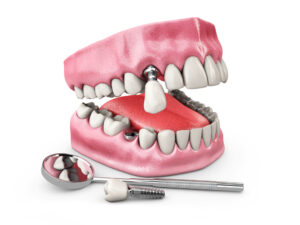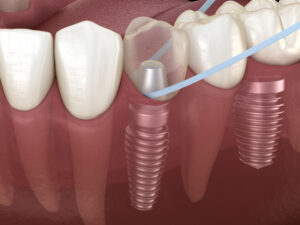What are the Signs of Dental Implant Failure?
 Dental implants are a wonderfully predictable way to replace missing teeth. Dentists have been using implants for decades with great long-term success. The risk for dental implant failure is generally low.
Dental implants are a wonderfully predictable way to replace missing teeth. Dentists have been using implants for decades with great long-term success. The risk for dental implant failure is generally low.
When it does occur, there are usually a few specific reasons. This blog will explain what you need to know about dental implant failure.
What is Dental Implant Failure?
Dental implant failure occurs when there is not a stable attachment between the implant body (the root replacement) and the surrounding jawbone. In a healthy, successful dental implant, the jawbone grows into and connects with the threads on the surface of the implant. The connection provides the support needed for chewing function and long-term stability.
When a dental implant fails, it is not connected to the surrounding jawbone, and it cannot function as it should. The good news is that a dental implant failure does not hurt. The bad news is that, because it does not hurt, you could be unaware of it until your dentist notices a problem.
What Causes Dental Implant Failure?
There are several risk factors that contribute to dental implant failure. Failure itself can occur in two ways. One is when the jawbone never forms an attachment with the implant. The other is when the jawbone had an attachment but lost it.
Failure of Implant to Attach to Jawbone
 When your dentist places a dental implant into the jawbone, there is a healing phase that lasts several months. During this healing, the jawbone should connect to the implant in a process known as osseointegration. Usually, this type of failure involves a problem with bone healing caused by systemic conditions.
When your dentist places a dental implant into the jawbone, there is a healing phase that lasts several months. During this healing, the jawbone should connect to the implant in a process known as osseointegration. Usually, this type of failure involves a problem with bone healing caused by systemic conditions.
- Smoking – Smokers have a high risk for dental implant failure. Nicotine use causes constriction of the tiny blood vessels, creating a lack of blood supply to the surgery site. Without good blood flow, the jawbone does not have the cells needed to create new bone attachments.
- Diabetes – Patients who are diabetic have a similar problem with healing as smokers do. Diabetes causes constriction of blood vessels in the extremities, and this affects the jawbone and gums. Poor blood flow equals poor wound healing.
- Long-Term Use of Proton Pump Inhibitors – Recent research is showing a high risk for dental implant failure among people who have taken proton pump inhibitor medication regularly. This type of acid reflux medication affects the calcium levels in bone and causes poor bone healing.
Loss of Attachment between Implant and Jawbone
The other general category of implant failure involves implants that did have an attachment and lost it. Overall, this happens when there is some type of trauma to the surrounding jawbone.
 Peri-Implantitis – While implants are impervious to cavities, they can suffer from gum disease. When it occurs on a tooth, we call it periodontitis. When it occurs on an implant, we call it peri-implantitis. Gum disease is a chronic bacterial infection and inflammatory disease that destroys the tissues surrounding a tooth or implant. Gum disease always begins with dental plaque buildup. Poor home care and a lack of professional teeth cleanings allows gum disease to progress unnoticed.
Peri-Implantitis – While implants are impervious to cavities, they can suffer from gum disease. When it occurs on a tooth, we call it periodontitis. When it occurs on an implant, we call it peri-implantitis. Gum disease is a chronic bacterial infection and inflammatory disease that destroys the tissues surrounding a tooth or implant. Gum disease always begins with dental plaque buildup. Poor home care and a lack of professional teeth cleanings allows gum disease to progress unnoticed.- Occlusal Trauma – We can also damage the connection between a dental implant and the surrounding bone through occlusal trauma. That means biting forces that are inappropriate. They may be forces that are too heavy, hitting on the wrong area of the implant crown, or in the wrong direction for the bite. The way a dental implant crown hits the opposite tooth during chewing is extremely important. When it is wrong, the implant can fail.
What are the Signs and Symptoms of Dental Implant Failure?
Because dental implant failure rarely causes any pain, the patients typically do not know that it is occurring. This emphasizes the importance of consistent follow-up visits with your dentist and dental hygienist. We can often stop dental implant failure if we catch it in the earliest stages.
Visible Bone Loss on an X-ray
When the implant is losing its attachment with the surrounding jawbone, we can see it on a dental x-ray. Appropriate follow-up care of a dental implant involves taking a full-length (of the implant) x-ray at least once per year.
Detectable Bone Loss through Gum Measurements
During teeth cleaning visits with your dental hygienist, he or she often uses a tiny instrument called a periodontal probe to take measurements of the tissues underneath the gums. These probing depths indicate where the bone attaches to a tooth or implant. A deep pocket (a probing depth measurement greater than 4mm) could mean there is active gum disease.
Looseness of Implant
As the surrounding bone detaches from the dental implant, the patient may notice a feeling of looseness. If the implant crown or cover screw seems to wiggle back and forth, get in to see your dentist immediately. The good news is that it does not always indicate an implant failure. You may simply need a tightening of the internal screws attaching the crown to the implant.
The bad news is that it could mean a loss of attachment and implant failure. Your dentist will be able to determine which it is.
Loss of Implant
It may sound funny, but there are cases of implant failure in which the dental implant actually just falls out of the mouth. The patient may be completely unaware of the problem until he have the implant body in his hands. Again, the good news is that this does not cause pain or discomfort.
The bad news is that the implant failed, and we must start the process again.
What Happens when a Dental Implant Fails?
We have the choice to place a new implant after one fails. It is best to determine the underlying risk factors that contributed to its failure first so that we can make changes and reduce the risk of failure in the next attempt.
Dr. Ann will work diligently to uncover the reasons your initial implant failed so that the prognosis of the next one is much better. We work with the medical doctors in our community closely to help manage any underlying health conditions that increase the risk for implant failure. If you’ve had an implant fail and would like to replace it, come see us. We love successfully restoring missing teeth with dental implants.
More Questions about Dental Implant Failure?
Call Designer Smiles today to schedule an implant consultation with Dr. Ann. She can answer any question you have about dental implants, your specific risk for failure, and how to reduce that risk.
